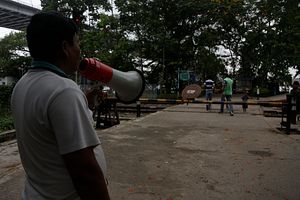Fani means a “snake” or a “hooded snake” in Bengali. And yet when the cyclone of that name made landfall in India in recent days, the country managed to stand fast and resist its bites.
The cyclone – labeled a category four out of five – stormed through the Bay of Bengal, hitting the Indian state of Odisha hardest but also further battering West Bengal and Bangladesh. In Odisha alone, sources speak of perhaps over a million people evacuated and of 12 to 29 casualties (although these numbers are bound to be updated as the event is very fresh). While the significance of even a single death should not be diminished, these numbers do confirm that the country has made great strides in facing the perpetual challenge of cyclonic demons that are born out of the Indian Ocean.
It is the coastal state of Odisha, located by the Bay of Bengal, that has often faced this natural threat. In 1999, it experienced one of the worst cyclones in its history, with the number of casualties reported as crossing the 10,000 mark (although lower and higher figures have also been given). Both the central Indian administration and the state-level government have worked to prevent such a tragic loss of life from happening again. Cyclone Phailin of 2013 and Titli of 2018, marked a few dozen fatalities in India, although Ockhi of 2017 swallowed more than 200 lives. All of this, however, has been many times less than the losses during the dreaded, unnamed cyclone of 1999. Arguably, while disaster management has improved, 20 years ago in Odisha it was particularly bad.
Reports suggest that at least four broader factors contributed to the relatively successful tackling Fani in Odisha: better cooperation and communication; a faster and more efficient warning system; a prompt and massive evacuation and the role of cyclone shelters.
Current technology allows warnings for incoming cyclones to be issued four days before landfall, not two days, as in 1999. The state of Odisha also cooperates more closely with the central authorities, such as the Indian Meteorological Department in Delhi. A communication network between various state agencies – also including the Indian Space Research Organization, National Remote Sensing Center, and others – was also created. Both the central and state governments have drawn up plans to tackle future natural calamities. Technology also facilitates quicker communication not only between the state and central level, and between government institutions, but also between the authorities and the common people. As India has witnessed a mobile phone revolution in recent years, these means of communication allowed the Odisha government to warn its citizens of an impeding threat.
A prompt evacuation was another key factor. The evacuation involved an estimated 1 million people. A similarly large-scale evacuation occurred during cyclone Phalin in 2013, and frequent drills also helped in raising readiness.
As for the cyclone shelters, it should be remembered that in India millions of people live in housing conditions that cannot withstand the wrath of a cyclone. The thatched huts of rural areas or the made-of-everything-one-can-find shelters of the slums can be easily torn apart by cyclone gusts that blow 150 to 180 km per hour.
There were less than 100 proper cyclone shelters in Odisha in 1999. Although different numbers are given, some sources suggest the existence of only 21 shelters back then, which altogether could house around 2,000 people, far below what was needed in a state of over 30 million people (the population of Odisha in 2001 was 36 million). Since then, however, the state has built hundreds of shelters – there are approximately 900 now – some with the help of the country’s top specialists and with a degree of assistance from the World Bank and the Global Facility for Disaster Reduction and Recovery. Government policies also suggest the use of other suitable buildings, such as schools, for the temporary purpose of shelter during such times.
Will this outcome affect Indian politics, as elections – both to the lower house of the country’s central Parliament and to Odisha’s state legislative assembly – are ongoing? No, it is too late for this. Odisha cast its votes before Fani’s arrival (otherwise, however, the state’s ruling party – Biju Janata Dal – would have scored additional points and this could have mattered as the party is not a part of any of the two rival coalitions). But there are other challenges for the future.
Fani, pronounced Foh-nee in Bengali, is the final of a set of eight names once assembled to christen subsequent upcoming cyclones. This is already a second set prepared since India began to name cyclones in 2004. India’s coast, particularly its portions that belong to the states of Andhra Pradesh and Odisha, will continue to be cyclone-prone. Disaster management has clearly become better, but challenges are on the rise as well. Fani struck outside the normal autumn cyclone season, and more recent cyclones have started to reach further inland, prompting the authorities to establish shelters there as well. Of India’s many challenges, the change of weather patterns in the Indian Ocean is a process which the country’s agencies will keep monitoring.

































